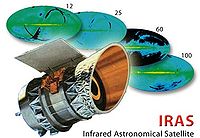- Infrared Astronomical Satellite
-
IRAS (télescope spatial)
 Pour les articles homonymes, voir IRAS (homonymie).
Pour les articles homonymes, voir IRAS (homonymie).IRAS Caractéristiques Organisation NASA, NIVR, SERC Domaine {{{domaine}}} Masse 1 075,9 kg Lancement 25 janvier 1983 à 02:17 UTC Lanceur Delta Fin de mission 21 novembre 1983 Durée {{{durée}}} Durée de vie {{{durée de vie}}} Désorbitage {{{désorbitage}}} Autres noms InfraRed Astronomical Satellite, Télescope spatial infrarouge IRAS Programme {{{programme}}} Index NSSDC 1983-004A Site irsa.ipac.caltech.edu Orbite Orbite polaire héliosynchrone Périapside 889 km Périgée {{{périgée}}} Apoapside 903 km Apogée {{{apogée}}} Altitude {{{altitude}}} Localisation {{{localisation}}} Période 103 min Inclinaison 99,1° Excentricité 0,000962 Demi-grand axe {{{demi-grand axe}}} Orbites {{{orbites}}} Télescope Type Télescope à réflecteur Diamètre 0,57 m Superficie Focale 5,5 m Champ Longueur d'onde infrarouge {{{instrument1_nom}}} {{{instrument1_type}}} {{{instrument2_nom}}} {{{instrument2_type}}} {{{instrument3_nom}}} {{{instrument3_type}}} {{{instrument4_nom}}} {{{instrument4_type}}} {{{instrument5_nom}}} {{{instrument5_type}}} {{{instrument6_nom}}} {{{instrument6_type}}} {{{instrument7_nom}}} {{{instrument7_type}}} {{{instrument8_nom}}} {{{instrument8_type}}} {{{instrument9_nom}}} {{{instrument9_type}}} {{{instrument10_nom}}} {{{instrument10_type}}} {{{instrument11_nom}}} {{{instrument11_type}}} {{{instrument12_nom}}} {{{instrument12_type}}} Lancé le 25 janvier 1983, IRAS a fonctionné pendant dix mois, jusqu'au 21 novembre 1983, sur une orbite héliosynchrone. Il a été un projet conjoint entre la National Aeronautics and Space Administration (NASA), l'agence spatiale néerlandaise (NIVR) et l'agence de la recherche britannique (SERC).
IRAS, pour Infrared Astronomical Satellite (« Satellite astronomique infrarouge »), ou le télescope spatial infrarouge IRAS: mission ayant pour objectif de réaliser un survey complet (une cartographie complète) du ciel dans les bandes infrarouges à 12, 25, 60 et 100 µm.
IRAS était doté d'un miroir de 0,57 mètre de diamètre. Il a effectué une couverture de 96 % du ciel à quatre longueurs d'onde, 12 µm, 25 µm, 60 µm et 100 µm, avec une résolution allant de 0,5 minute d'arc à 12 µm à 2 minutes d'arc à 100 µm. Il a découvert environ 500 000 sources dont de nombreuses n'ont pas encore été identifiées. Environ 75 000 d'entre elles sont soupçonnées d'être des galaxies de type starburst, c'est-à-dire toujours dans leur phase de formation d'étoiles. La plupart des autres sources sont probablement des étoiles entourées de disques de poussières, éventuellement en train d'évoluer en système planétaire. Les découvertes d'IRAS incluent entre autres la découverte d'un disque de poussières autour de Véga et les premières images du centre galactique, impossible à observer dans le domaine visible du fait de l'absorption considérable du milieu interstellaire.
Comme beaucoup de satellites infrarouges, la durée de vie d'IRAS a été limitée par son système de refroidissement : pour pouvoir observer efficacement à ces longueurs d'ondes, le satellite devant être refroidi à des températures très basses. Dans le cas d'IRAS, un réservoir de 720 litres d'hélium superfluide (soit 77 kg) permettait de maintenir le satellite à une température de 1,6 kelvin. La température était maintenue grâce à l'évaporation progressive de l'hélium. Quand la totalité de l'hélium fut épuisée, le satellite devint incapable de se maintenir à une température adéquate d'observation.
Cette cartographie, obtenue à partir d'un instrument optimisé pour détecter des sources ponctuelles, fut une réussite, donnant une nouvelle vision de l'univers dans une fenêtre presque impossible à observer depuis le sol. Ainsi, environ 350 000 sources infrarouges furent cataloguées, la plupart étant nouvelles. Rappelons que, en astronomie, l'infrarouge permet d'observer des sources froides (à quelques dizaines de kelvins), ce qui correspond le plus souvent à de la poussière, précurseur ou fin d'étoiles.
Parmi les observations et les résultats scientifiques d'IRAS, on notera les premières observations :
- d'un disque de poussière autour de l'étoile Véga
- des nuages (nommés cirrus) de poussières d'avant-plan (dans notre Galaxie), omniprésents
- du cœur de notre galaxie, la Voie lactée, obscurcie par la poussière
- une émission IR émise par des galaxies en interaction
En plus de sa mission première, IRAS a également découvert trois astéroïdes, dont notamment 3200 Phaéton (un astéroïde géocroiseur responsable de la pluie d'étoiles filantes des Géminides), ainsi que la comète périodique 126P/IRAS.
Astéroïdes découverts : 3 (3200) Phaéton 11 octobre 1983 (3728) IRAS 23 août 1983 (10714) 1983 QG 31 août 1983 Le succès d'IRAS poussa l'agence spatiale européenne à décider son successeur, ISO, et la National Aeronautics and Space Administration, Sirtf/Spitzer, qui prit de nombreuses années de retard sur le calendrier initial.
Voir aussi
Liens internes
Liens externes
- (en) Site IRAS à la NASA
- (en) Description d'IRAS par IPAC, laboratoire à CalTech
- (en) Site IRAS de Ball Aerospace
- Portail de l’astronomie
- Portail de l’astronautique
Catégories : Observatoire spatial infrarouge | Découvreur d'astéroïde (observatoire) | Satellite scientifique
Wikimedia Foundation. 2010.

